
|
|
|
|
|
| Issue 25: | 22 Sept. 2024 |
| Essay: | 3,142 words |
| + Citations: | 570 words |
| Publisher’s Notes: | 133 words |
Essay and Visual Artworks
by Kendall Johnson
Writing for Vision, Part 3
Seeing Beyond the Clamorous Now
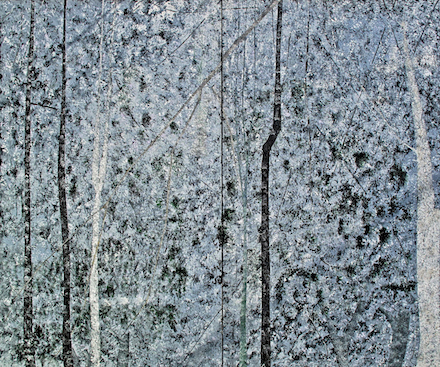
Yukon (painting, 2007) copyrighted © by Kendall Johnson.1
I sit by my client, Phil. Twenty-five or so years my senior, Phil is seeing me professionally in support of his wife, who is fighting for her life against a vicious and fast-moving cancer. Part of his agenda is to find something to hold on to as he battles that as well as his own, slower acting malignancy. Phil seeks warmth as his life options narrow. I struggle for words for Phil.
We are facing a large abstract painting I have just finished and now have hanging in my office. The cool blues, white dapples, and dark vertical upright lines evoke calm. Phil doesn’t speak for a bit, and then I sense his body relaxing. I begin gently, “What do you see, my friend?”
Phil is smiling. “After the war, my first job was with the FAA, operating a radio off Alaska on one of the Aleutian Islands. One of the other guys ran a trap line as a hobby and asked if I’d like to go with him on his next trap run. Two days, out and back.
“The next day I found myself on a dog sled, busting across snow fields to check traps. A weather front came in and we put up in a copse of pines for shelter. We built a fire and covered up while the snow fell heavily all around. This painting takes me back there, smelling the wood smoke, listening to the snow clump off the trees. There we were, middle of nowhere, warm and cozy.”
Staring at the painting, Phil had found the comfort he needed. Such is the power of art, especially if the work, and the setting, allow interpretation and don’t jam preconceptions on the viewer. The painting allowed Phil to read what he needed into the moment. It invited him to pull on his own meaning, by the suggestive images, hues, and tone.
I find some artists especially evocative, particularly J. M. W. Turner, Claude Monet, and George Inness. These landscape artists variously represent the divergent traditions of Realism, Romanticism, Impressionism, and early Tonalism. More important, each somehow captures the sublime—not just the beauty, but the sense of awe—in their work. Perhaps they can speak to writers today, you and me, as we try to find meaning in a world gone terribly awry.
We write to be read. We follow other writers, take the important workshops, and try to fit our latest pieces into the correct journals that can lead to our own work being noticed. We look for inspiration. But in this discussion, we look at what visual artists tell us about what we can find to guide us if we allow ourselves to expand our vision. It’s about seeing, and re-seeing, and looking beyond what we see.
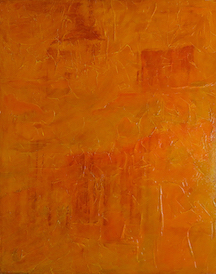
Primitive (2004-05) copyrighted © by Kendall Johnson.2
When Words Fail
It is necessary to mark the greater from the lesser truth: ... that which addresses itself to the imagination from that which is solely addressed to the eye.
—J. M. W. Turner3
It’s late 2017, and Trump’s presidency is symptomatic. My nation, my home town are fraying. It is beginning to feel like 1967, a time I recall too well. I returned from Vietnam that year, and found everything had changed from the place I had left to something best described by the then popular band Jefferson Airplane: an acid-laced version of Alice’s Wonderland. 2017 is feeling like that. Political division is worsening, massive forest fires bespeak unheeded climate breakdown, and large-scale school shootings lay open our nation’s propensity for and tolerance of physical violence. My wife and I escape to old England to seek calm in the Cotswold countryside, only to discover the isolationist incendiaries of Brexit.
We find ourselves wandering the galleries of the Tate Britain and come across a J. M. W. Turner exhibit.4 Turner was born just before the American Revolution, and painted well into the 19th century. I remember hearing an art critic, a specialist on Modernism, recommending investing in Turner paintings because of their pivotal position historically. Despite my search for the more contemporary painters, I decide to look closer.
There stand his large atmospherics, his radiant Angel Standing in the Sun, 1846, his broiling sea disaster and storm scenes, his stark contrast between the overwhelming forces of nature and the emerging human order. His placing of small figures against overwhelming natural forces, a favorite trope of other Romantic era painters, was believable. Not only did he avoid the schmaltz of nationalism or nostalgia for a wished-for past, but he opened the door to implicit transcendence. “The Sun is God” interpretation of his work is not far off. He speaks to the very reason we find ourselves here, in this moment.
Though some commentators argue that his work was the result of various physical and psychological disorders, it is likely that it was his dogged individualism that created more critique than did his work.5 His painting invites us to look for underlying and less visible forces that we, in our haste to move on to the next crisis, the next spectacle, often choose not to see.
As the day warms and city falls away, sights, smells, and sounds of wild replace discordance from below .... A hawk cries raspy shriek overhead. Breathe deeply chamise, creosote, rosemary, sage. A terpene heaven; eucalyptus, and sharp pine all bringing us here, home now.6
At a time when others were painting florals, fancied landscapes, and courtly gesture, Turner turned on blinding light, and portrayed scenes that transcended everyday scale. He painted sublime vision.
But does this talk of paintings tell us anything about meaningful writing, and especially during times like ours? Turner followed the events of his day and painted them, but his work was always informed by his larger concern: capturing the divine light. It’s as if this painter, born at the outset of the American Revolution against English colonialism, has a clear message for me, for all of us writers, while we are facing the far deeper crises of today. I hear him telling us:
... while you talk about current situations, infuse your writing with the bigger picture, the images that are central to your own world.
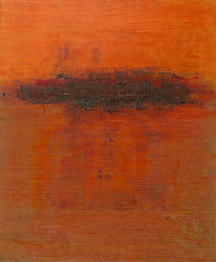
Plenitude (painting, 2007) copyrighted © by Kendall Johnson.7
Pointing to the Great Beyond
I am chasing a dream, I want the unattainable. ...I want to paint the air which surrounds the bridge, the house, the boat; the beauty of the air in which these objects are located; and that is nothing short of impossible.
—Claude Monet8
This morning I read that the Courtauld Institute of the Arts in London is preparing to exhibit Claude Monet’s Thames series.9 The Brits seem to love to exhibit foreign artists who have painted Britain, and the last time I was there was for the Van Gogh in Britain exhibit in 2019.
I remember meeting Monet up close years before. During the harrowing months following the 9/11/01 attack on the World Trade Center in New York, I took a break from my crisis work and visited the Museum of Modern Art. There I found myself sitting in a spacious darkened gallery facing a massive mural (over six feet tall by forty wide) of Monet’s Waterlilies. I knew enough about the artist from coursework, but simply wasn’t prepared for the dimensionality. The paint, in bits and daubs of pure color, stood out from the wall in impasto sometimes inches thick. Whether up close or from far back, the painting breathed life. My head at the time, boiling with images of 9/11 turmoil and pain, was bathed in the cool waters of Giverny.
I have since prowled art museums on the lookout for more of his handling of texture and light but found his best series on a website. It turned out Monet had spent time in London, during the Franco-Prussian War of 1870, when he sought sanctuary from the draft. He was so moved by the coastal London light that he returned on three separate occasions, staying in hotels and painting the Thames under the rapidly changing weather conditions. On one of the visits he writes to his wife Emily:
Today was a day of terrible struggle, and it will be the same until I leave. Only I need more canvases: there’s no other way to get anything done, than to have different ones going for all kinds of weather, all kinds of harmonies, that’s the real way to do it....10
During that time, his work there even drew critical notice back in Paris. One critic wrote of his London series:
... in his desire to paint the most complex effects of light Monet seems to have attained the extreme limits of art.... He wanted to explore the inexplorable, to express the inexpressible, to build, as the popular expression has it, on the fogs of the Thames! And worst still, he succeeded.11
Yet in making sense of his work, it may help to question his intent rather than focus on his technique. Often labeled as non-realistic and disconnected, a step toward Seurat’s pointillism and expressionist abstraction, perhaps Monet simply looked more closely at the real than the rest. His work, sometimes dismissed as optical parlor tricks, the juxtaposition of bits of contrasting colors, may actually represent the closest thing to realism we know. Our neurological perception of color—the product of our rods, cones, and occipital lobes—upon which empirical science is based, is merely the best we can do to make sense of the buzzing confusion around us. His technique mimicked the way our senses work. But that’s just the beginning.
Monet’s London pieces reach for the sky. Monet found in his sensitivity to the effects of London smoke, drizzle, and mist upon light, what he’d been trying to capture in his all of his studies of hay bales and cathedrals in French countryside light. Further, his experiments in color allow us to appreciate what we really could see as we glance around us. To look closely at Monet looking closely at the world is to lose oneself in the sublime.
Monet guides me again as I walk in the foothills just above my town:
Along this very path I have walked for centuries. Before it grew this tree, I was already becoming this rock outcropping. The sun burns as all stars do until at last, they stop, then particles dance in darkness. heat shimmer vision: distortion blocks distortion and all is revealed12
Claude Monet’s work alongside the Thames in London at the turn of the last century as the onset of industrialism and change swept the world, carries import for us. Through his paintbrush he seems to be saying to writers such as myself and you as we muddle our way into an uncertain future:
... do not be afraid to use language like I use paint: be bold, do justice toward your subject matter. But do so in such a manner that points out the deeper implications, the important ones that lie beyond the surface.
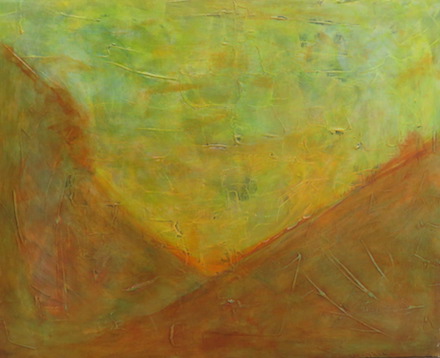
Passage (painting, 2018) copyrighted © by Kendall Johnson.13
Sharing the Mystery Within All Things
The true use of art is, first, to cultivate the artist’s own spiritual nature.
—George Inness14
I sit in my chiropractor’s office, waiting to have my knots and scars, the product of a half-life of rampant physicality, loosened. The good doctor is quite good, and more than that, knows and walks in the wilderness area I favor, near town. His office is in a restored Craftsman-styled home, and decorated with George Inness prints. I get lost in them, and hope to bring some of their glow into my own art, as I prepare another series about Johnson’s Pasture. I’d seen Inness prints before, but none this big, this good. My various injury-related aches awaiting treatment fade into background while I again walk forest paths and bathe in moonlight.
“Oh, I see you like Inness,” the doctor’s voice breaks into my reverie. He smiles. “Come on back and let’s see what we can do.”
Sometimes you’ve got to live a little to discover your own gift. Other’s ideas seem a shortcut to get you where you want to become, but usually fall short. George Inness wanted to capture the spirit he sensed in the world. A follower of scientist/mystic Emanuel Swedenborg, he sought to incorporate the divine into his work. He spent much of his life trying to emulate the 18th and 19th century landscapes he found in the museums. Following the European masters through Italy and France, soaking up Barbizon realism, he returned to New York and New Jersey, hanging out with, then breaking away from, the early Hudson River School painters who tried to manifest the transcendentalist world view in their realistic depictions of nature. The natural order, they believed, was guided by God.
It wasn’t until he was sixty years old that he found how to paint the spirit he felt in the fields and forests, not a separate God apart from nature. Unlike Turner and Monet, Inness did not just find evidence for God in nature, or see “God’s light” peeking around vast mountain panoramas; instead he sought the God that was nature. Imaging nature itself as divine in this way was this artist’s task. Finally, in the late 1880s, in his last decade, many now believe he finally found that way.15 Using various “scumbled” muted hues overlaying a nuanced study of underlying light values from darkest to light, he suggests the subtle underlying spiritual nature of each setting. Avoiding clearly defined, intensely colored shapes, he points out the true nature of the world. He shows us the world we could see if we look closely. He shows me how to again walk in Johnson’s Pasture, and begin to see what is actually there.
I write:
Maybe the atheists are right and no god exists, or materialists, and the world is random accident. But you can’t tell me that as I watch the grass dance and winds send wave rippling down hillside hawks riding wild currents higher.16 here is the magic here, the mystery
As a painter, George Inness is hard to label. He’s figurative, yet he shifted the objects of his painting from trees to the inner spirits of the tree. He utilizes rich abstraction in abundance yet then himself claims it realistic. He paints in lights and shadows but does so in lyric poetry. His many admirers seek to identify his techniques and style with their particular approach—Tonalism, Spiritualism—but he resists critical categories. He directly paints the magic and mystery.
Further, this artist of over a century ago has much to say to writers today. I see him aghast at television, internet, and the frenzy and panic that is today, and I hear him cautioning our writing to resist the fashion trends. Inness tells us clearly:
Write what matters to you the most existentially, not just what you think will impress others. Therein lies your authentic voice.
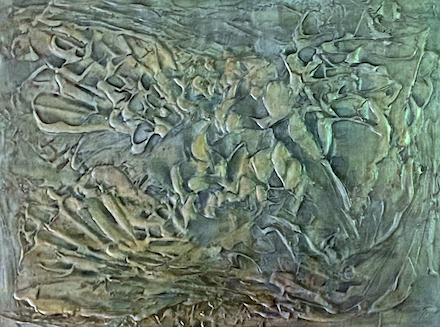
Emergence (for Patricia Squires Johnson), 2013
Copyrighted © by Kendall Johnson.17
Living the Questions
At present you need to live the question. Perhaps you will gradually, without noticing it, find yourself experiencing the answer, some distant day.
—Rainer Maria Rilke18
I sit on the steps leading down into my painting studio, making a final review of a painting I’ve finished, checking out composition, values, hues, design. I look away, then back, and then I see it anew. I suddenly find myself weeping. The work leading up to the painting had been hard. My mother was nearing the end of her life, and at the same time was losing her sight. A watercolorist, sensitive to nature, a lover of art, she was losing a main source of joy. I’d finally hit on a plan. A piece so heavily textured she would be able to explore it for hours. She could see it tactilely, through her fingers, and so the contours would be the message. Even the coloration would be secondary, like a bas-relief sculpture in a darkened room. And now, the finished piece curing in the sun, I saw what I had done. I could feel how I’d been simply a vehicle for the artwork; it had come from somewhere beyond me and had passed through me on its way to the world.
The wonderment I felt, the awe, must be similar to that felt by Turner, Monet, and Inness. I didn’t have to be a master painter to feel their joy. If they managed to get beyond their necessary inner critics, their own self-doubts, their perception of the distance between their aesthetic aspirations and their performance, they very likely occasionally sat back and wondered, like me, how the work had somehow survived their limitations and failures. They had been the vehicle through which Turner’s Angel Standing in the Sun, Monet’s Parliament Buildings in Evening, and Inness’ A Hazy Morning in Montclair had come to be. Did they, like we, disbelieve what they’d just done? Did they, too, feel a sense of undeserved privilege?
When we read what the philosophers, literary critics, and academics say about “the sublime,” the conversations normally explore viewers’ reactions to sublime art pieces, or the nature and characteristics of the objects portrayed by the art. I’d like to suggest a refocus, a different perspective.
Instead of describing a quality adhering to objects in the world, perhaps a better use of “the sublime” may not be an adjective, a descriptor of the external world at all. Could it be that “sublime” is best seen as the reaction the artist or writer has when they realize they have outdone themselves, that their work has revealed something larger, beyond themselves? Maybe it is the reaction of the creator to the very experience of creativity. An adverb. As in “she paints, writes sublimely,” or “he walked sublimely through the morning light.”
It may be that the main message of these three artists to writers of today may be based less upon what we should write, than why and how. More about our purpose, the way we approach our writing, and how it feels to write our most important work.
I hear them saying:
~ Talk about current situations, but infuse your writing with the bigger picture, images that are central to your world.
~ Do not be afraid to use language like we used paint: be bold, do justice toward your subject matter. Do so in such a manner that points out the deeper implications, truths that lie beyond the surface.
~ Write what matters to you personally, existentially; write what has not been said enough, not just what you think will impress others. Therein lies authenticity and your own true voice.
Citations and Author’s Notes:
All links were confirmed on 19 September 2024.
- Kendall Johnson. Yukon (2007). Painting, acrylic on canvas (60″x80″).
- Kendall Johnson. Primitive (2004-05). Painting, acrylic on canvas (40″x30″).
- Joseph Mallord William Turner. Quoted in The Life and Masterworks of J. M. W. Turner by Eric Shanes (Parkstone Press, 2008).
- As Johnson notes: The Tate Britain’s collection is large, well organized, and freely accessible online. Anyone interested in studying Turner’s atmospherics would do well to start there:
https://www.tate.org.uk/visit/tate-britain/display/jmw-turner - As Johnson notes: The same was and still is claimed of the work of another artist, Vincent van Gogh. I have argued elsewhere, as both therapist and artist, that criticisms based upon Argument ad Hominem claims cannot dispute the quality of the work. See my book Dear Vincent: A Psychologist turned Artist Writes Back to Van Gogh (Sasse Museum of Art, 2020), available online:
https://view.publitas.com/inland-empire-museum-of-art/dear-vincent/page/1 - Adapted from Johnson’s Pasture: Living Place, Living Time by Kendall Johnson (Claremont, CA: Claremont Heritage; 2 March 2018).
- Kendall Johnson. Plenitude (2007). Painting, mixed media (24″x18″).
- Claude Monet. Quoted in Monet at Giverny by Caroline Holmes (London, UK: Seven Dials, 2001).
- As Johnson notes: The Griffin Catalyst Exhibition: Monet and London. Views of the Thames runs from September 27 to January 19, 2025:
https://courtauld.ac.uk/whats-on/exh-monet-and-london-views-of-the-thames/
The paintings can be viewed in “Courtauld to Exhibit Claude Monet’s Paintings of London for the First Time in 120 Years” at ARTNews (25 June 2024):
https://www.artnews.com/art-news/news/claude-monet-paintings-london-courtauld-1234710647/ - Letter from Claude Monet to Alice Monet, 18 March 1900, quoted in Claude Monet in Great Britain by Sylvie Patin, translated by Maev de la Guardia (TOTAL+Hazan: Paris, 1994); and retrieved from an article in the Tate Britain newsletter, Tate Etc. (12 September 2017), “‘I find London lovelier to paint each day’: Claude Monet in London”:
https://www.tate.org.uk/tate-etc/issue-41-autumn-2017/claude-monet-i-find-london-lovelier-paint-each-day - Quoted in Monet in the ’90s: The Series Paintings by P. H. Tucker (New Haven and London, 1989), page 267; and retrieved from Christie’s Lot Essay 24A, for the auction of Monet’s The Houses of Parliament, at Sunset in 2015:
https://www.christies.com/en/lot/lot-5895978 - Adapted from Johnson’s Pasture: Living Place, Living Time by Kendall Johnson (Claremont, CA: Claremont Heritage; 2 March 2018), page 43.
- Kendall Johnson. Passage (2018). Painting, acrylic on canvas (24″x30″).
- George Inness. In the interview “A Painter on Painting” in Harper’s New Monthly Magazine, Volume 56 (1877-78), February 1878, page 461. Full text digitized by Cornell University (see pp. 458-461): https://babel.hathitrust.org/cgi/pt?id=coo.31924079630608&seq=471&q1=spiritual+nature
- As Johnson notes: For a concise, brilliant essay on George Inness, with a collection of his later paintings, one can’t do better than the article by Christopher Volpe in the Tonalism newsletter:
https://www.tonalism.com/historical/george-inness - Adapted from Johnson’s Pasture: Living Place, Living Time by Kendall Johnson (Claremont, CA: Claremont Heritage; 2 March 2018), page 25.
- Kendall Johnson. Emergence (for Patricia Squires Johnson), 2003. Painting, acrylic on canvas (30″x40″).
- Rainer Maria Rilke. Quoted from his fourth letter in Letters to a Young Poet, as translated by Joan M. Burnham (New World Library, 2000), page 35:
https://books.google.com/books?id=_wofmBiXXv0C&q=live+the+questions#v=snippet&q=experiecing%20the%20answer%2C%20some%20distant&f=false
Publisher’s Notes:
1. Please stay tuned to this website for additional essays in this Writing for Vision series by Kendall Johnson. The first two essays in the series also appear in MacQ:
Part 1: Interior Lighting: Abstraction and the Concrete, Issue 23 (28 April 2024); and
Part 2: Grounding: What Land Art Tells Us of the Long Walk Home, Issue 24 (30 August 2024).
2. On a related note, the six essays of Johnson’s Writing to Heal series are published in MacQueen’s Quinterly online (Issues 16-19, 20X, and 22), as well as in a printed collection released by MacQ in May 2024.
The book also includes a few of his poems and 21 of his artworks in full color, as described in Issue 23 of MacQ: Writing to Heal: Self-Care for Creators.
Kendall Johnson
grew up in the lemon groves in Southern California, raised by assorted coyotes and bobcats. A former firefighter with military experience, he served as traumatic stress therapist and crisis consultant—often in the field. A nationally certified teacher, he taught art and writing, served as a gallery director, and still serves on the board of the Sasse Museum of Art, for whom he authored the museum books Fragments: An Archeology of Memory (2017), an attempt to use art and writing to retrieve lost memories of combat, and Dear Vincent: A Psychologist Turned Artist Writes Back to Van Gogh (2020). He holds national board certification as an art teacher for adolescents to young adults.
Dr. Johnson retired from teaching and clinical work two years ago to pursue painting, photography, and writing full time. In that capacity he has written five literary books of artwork and poetry; one art-history book; and a hybrid collection of essays, memoir, poetry, and visual art, Writing to Heal: Self-Care for Creators (May 2024). His memoir collection, Chaos & Ash, was released from Pelekinesis in 2020, his Black Box Poetics from Bamboo Dart Press in 2021, and his The Stardust Mirage from Cholla Needles Press in 2022. His Fireflies series is published by Arroyo Seco Press: Fireflies Against Darkness (2021), More Fireflies (2022), and The Fireflies Around Us (2023).
His shorter work has appeared in Chiron Review, Cultural Weekly, Literary Hub, MacQueen’s Quinterly, Quarks Ediciones Digitales, and Shark Reef; and was translated into Chinese by Poetry Hall: A Chinese and English Bi-Lingual Journal. He serves as contributing editor for the Journal of Radical Wonder.
Author’s website: www.layeredmeaning.com
More on the Web: By, About, and Beyond
⚡ Through a Curatorial Eye: The Apocalypse This Time, an essay and paintings by Kendall Johnson in Issue 19 of MacQueen’s Quinterly (15 Aug. 2023); nominated by MacQ for the Pushcart Prize
⚡ Kendall Johnson’s Black Box Poetics is out today on Bamboo Dart Press, an interview by Dennis Callaci in Shrimper Records blog (10 June 2021)
⚡ Self Portraits: A Review of Kendall Johnson’s Dear Vincent, by Trevor Losh-Johnson in The Ekphrastic Review (6 March 2020)
⚡ On the Ground Fighting a New American Wildfire by Kendall Johnson at Literary Hub (12 August 2020), a selection from his memoir collection Chaos & Ash (Pelekinesis, 2020)
⚡ A review of Chaos & Ash by John Brantingham in Tears in the Fence (2 January 2021)
| Copyright © 2019-2025 by MacQueen’s Quinterly and by those whose works appear here. | |
| Logo and website designed and built by Clare MacQueen; copyrighted © 2019-2025. | |
|
Data collection, storage, assimilation, or interpretation of this publication, in whole or in part, for the purpose of AI training are expressly forbidden, no exceptions. |
At MacQ, we take your privacy seriously. We do not collect, sell, rent, or exchange your name and email address, or any other information about you, to third parties for marketing purposes. When you contact us, we will use your name and email address only in order to respond to your questions, comments, etc.